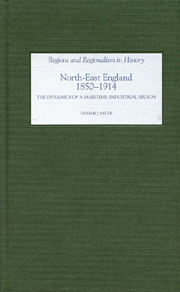Book contents
- Frontmatter
- Contents
- Dedication
- List of illustrations
- Preface
- 1 The North East in time and space
- 2 Horizons: ports, trade and mobility
- 3 Hinterlands and industrial districts
- 4 Making and managing the maritime landscape
- 5 Cohesion and diversity in the maritime urban system
- 6 The horizons of North East shipowning
- 7 Business and the maritime-industrial complex
- 8 Conclusion
- Sources and bibliography
- Index
2 - Horizons: ports, trade and mobility
Published online by Cambridge University Press: 12 September 2012
- Frontmatter
- Contents
- Dedication
- List of illustrations
- Preface
- 1 The North East in time and space
- 2 Horizons: ports, trade and mobility
- 3 Hinterlands and industrial districts
- 4 Making and managing the maritime landscape
- 5 Cohesion and diversity in the maritime urban system
- 6 The horizons of North East shipowning
- 7 Business and the maritime-industrial complex
- 8 Conclusion
- Sources and bibliography
- Index
Summary
The British liked to see themselves at the hub of a shrinking and increasingly interconnected world in the later nineteenth century, and one that was being created by their own technical and scientific prowess. In 1881, Joseph Cowen, a radical Tyneside newspaper proprietor, claimed that ‘the city of Chicago now is as near Newcastle, for commercial purposes, as the city of York was one hundred years ago’. Cowen was speaking at an event celebrating the life of the engineer George Stephenson, and thinking, as he often did, with one eye on his local roots and another on wider horizons. Cowen's main point was that a smaller, more competitive world meant that the North East needed to improve its education and training if it was to maintain the economic lead bequeathed by the likes of Stephenson. Judging by the cheers from his audience, though, they were happy to interpret his words as a more simplistic boosterism, revelling in the North East's role on the global stage.
The North East was very much in step with some of the broader assumptions of later Victorian Britain. Trade had long been central to its economy, and Newcastle in particular was a wealthy merchant town for centuries before the advent of heavy industry, with an elite that mixed trade, land and industry in differing proportions over time. Indeed, as with British history in general, manufacturing has had an unjustifiably high profile in historical writing about the North East, to the neglect of a powerful and persistent mercantile and commercial sector.
- Type
- Chapter
- Information
- North East England, 1850–1914The Dynamics of a Maritime-Industrial Region, pp. 16 - 50Publisher: Boydell & BrewerPrint publication year: 2006



